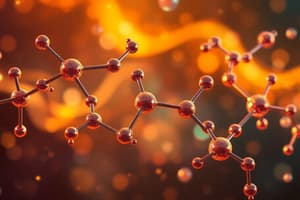Podcast
Questions and Answers
What type of mutation can change protein encoding?
What type of mutation can change protein encoding?
- Gene insertions
- Point mutations (correct)
- Deletions from horizontal transfer
- mecA gene mutations
In phylogenetics, what does a cluster of similar organisms based on DNA or protein sequences represent?
In phylogenetics, what does a cluster of similar organisms based on DNA or protein sequences represent?
- Gene insertions
- Clade (correct)
- Distant Relatives
- Horizontal transfer
How is genetic distance typically summarized in phylogenetics?
How is genetic distance typically summarized in phylogenetics?
- % Difference
- % Mutation Rate
- % Phylogeny
- % Similarity (correct)
Which type of tree in phylogenetics shows the inferred most recent ancestor at each node?
Which type of tree in phylogenetics shows the inferred most recent ancestor at each node?
What practical application does classification have in genomics and phylogenetics?
What practical application does classification have in genomics and phylogenetics?
What can horizontal transfer contribute to in terms of genomic diversity?
What can horizontal transfer contribute to in terms of genomic diversity?
What is the distinguishing feature of genomics among the taxonomy methods mentioned in the text?
What is the distinguishing feature of genomics among the taxonomy methods mentioned in the text?
Which of the following is NOT a method used in genomics?
Which of the following is NOT a method used in genomics?
In taxonomic classification, what can cause confusion when based on genetics?
In taxonomic classification, what can cause confusion when based on genetics?
What is the main purpose of using 16S rRNA in phylogenetics?
What is the main purpose of using 16S rRNA in phylogenetics?
Which method provides the LEAST detailed information in microbial taxonomy?
Which method provides the LEAST detailed information in microbial taxonomy?
What term refers to the passage of genetic information from parent to offspring?
What term refers to the passage of genetic information from parent to offspring?
Which of the following is true about the International committee for taxonomy of viruses (ICTV) system?
Which of the following is true about the International committee for taxonomy of viruses (ICTV) system?
What is a key characteristic of prions?
What is a key characteristic of prions?
Which domain does the biological entity 'Proteobacteria' belong to?
Which domain does the biological entity 'Proteobacteria' belong to?
What is the primary source of reproduction for viruses?
What is the primary source of reproduction for viruses?
What is the main criterion for defining a species according to the taxonomic ranks mentioned in the text?
What is the main criterion for defining a species according to the taxonomic ranks mentioned in the text?
Which of the following classification systems is NOT used for viral classification?
Which of the following classification systems is NOT used for viral classification?
In microbiology, how is a 'strain' typically defined?
In microbiology, how is a 'strain' typically defined?
What distinguishes prions from viruses?
What distinguishes prions from viruses?
When referring to non-sexually reproducing organisms like bacteria, what constitutes a 'species' according to the text?
When referring to non-sexually reproducing organisms like bacteria, what constitutes a 'species' according to the text?
How are new genetic variants within a bacterial species typically described?
How are new genetic variants within a bacterial species typically described?
What term is used to describe a group of living organisms capable of interbreeding, even if geographically isolated?
What term is used to describe a group of living organisms capable of interbreeding, even if geographically isolated?
Which taxonomic rank defines a group that shares stable properties but differs significantly from other groups of strains in microbiology?
Which taxonomic rank defines a group that shares stable properties but differs significantly from other groups of strains in microbiology?
Which biosafety level is associated with organisms causing severe human disease with no effective prophylaxis, treatment, or vaccination available?
Which biosafety level is associated with organisms causing severe human disease with no effective prophylaxis, treatment, or vaccination available?
What type of organisms are handled in BSL-4 facilities?
What type of organisms are handled in BSL-4 facilities?
What type of suits do personnel wear in BSL-4 facilities?
What type of suits do personnel wear in BSL-4 facilities?
Which of the following is true about BSL-3 facilities?
Which of the following is true about BSL-3 facilities?
What is a common feature of BSL-3 and BSL-4 facilities?
What is a common feature of BSL-3 and BSL-4 facilities?
Which biosafety level involves personnel wearing laboratory specific PPE (or disposable), under negative air pressure?
Which biosafety level involves personnel wearing laboratory specific PPE (or disposable), under negative air pressure?
What are the two competing systems for viral classification mentioned in the text?
What are the two competing systems for viral classification mentioned in the text?
What distinguishes prions from viruses?
What distinguishes prions from viruses?
List the taxonomic ranks from Domain down to Species for the biological entity 'Homo sapiens'.
List the taxonomic ranks from Domain down to Species for the biological entity 'Homo sapiens'.
Explain the significance of different serotypes within a bacterial species.
Explain the significance of different serotypes within a bacterial species.
Discuss the challenges associated with defining a bacterial species based on genetics.
Discuss the challenges associated with defining a bacterial species based on genetics.
Compare and contrast the classification methods used in genomics and phylogenetics.
Compare and contrast the classification methods used in genomics and phylogenetics.
Define a strain in microbiology and provide an example.
Define a strain in microbiology and provide an example.
Explain the concept of species in microbiology for organisms that do not reproduce sexually.
Explain the concept of species in microbiology for organisms that do not reproduce sexually.
Differentiate between a species and a strain in microbiology, providing clear examples for each.
Differentiate between a species and a strain in microbiology, providing clear examples for each.
Explain the taxonomic rank of species in microbiology and how it helps in classifying bacterial organisms.
Explain the taxonomic rank of species in microbiology and how it helps in classifying bacterial organisms.
Which scientist first described the current three kingdoms of life Bacteria, Archea, Eucarya
Which scientist first described the current three kingdoms of life Bacteria, Archea, Eucarya
Which of the following would be an example of the species level of taxonomic classification
Which of the following would be an example of the species level of taxonomic classification
1 pts
Which of the following statements are true?
-
Taxonomy is the area of biological systematics by which life is defined by shared characteristics
-
Linnaeus first described the Protista in 1735
-
The definition of a species is the same for both sexually and asexually reproducing organisms
1 pts Which of the following statements are true?
-
Taxonomy is the area of biological systematics by which life is defined by shared characteristics
-
Linnaeus first described the Protista in 1735
-
The definition of a species is the same for both sexually and asexually reproducing organisms
Which of following is the proper term which would define a bacterium that has lives at extremely cold temperatures?
Which of following is the proper term which would define a bacterium that has lives at extremely cold temperatures?
Which of the following is an example of an acellular organism
Which of the following is an example of an acellular organism
Which of the following statements are true?
-
An organism which is able to survive in extreme conditions (e.g. temperature, pH etc) is called an extremophobe
-
The serotyping of Salmonella relies on the H and O antigens
-
Genotype classification can be confused by vertical gene transmission
Which of the following statements are true?
-
An organism which is able to survive in extreme conditions (e.g. temperature, pH etc) is called an extremophobe
-
The serotyping of Salmonella relies on the H and O antigens
-
Genotype classification can be confused by vertical gene transmission
Which of the following statements are true
-
A microbial species is a group of microorganisms that are capable of interbreeding even if geographically isolated
-
A microbial species is a collection of strains which share stable properties but had significant differences to other strains
-
A microbial species is a collection of strains which only vary slightly from different species through minor genetic changes
Which of the following statements are true
-
A microbial species is a group of microorganisms that are capable of interbreeding even if geographically isolated
-
A microbial species is a collection of strains which share stable properties but had significant differences to other strains
-
A microbial species is a collection of strains which only vary slightly from different species through minor genetic changes
Which of the following was one of the kingdoms of life as described by Haeckel
Which of the following was one of the kingdoms of life as described by Haeckel
Which of the following would be an example of how bacteria could be classified phenotypically by biochemistry?
Which of the following would be an example of how bacteria could be classified phenotypically by biochemistry?
Which of the following describes the assignment of names to different types of organisms
Which of the following describes the assignment of names to different types of organisms





